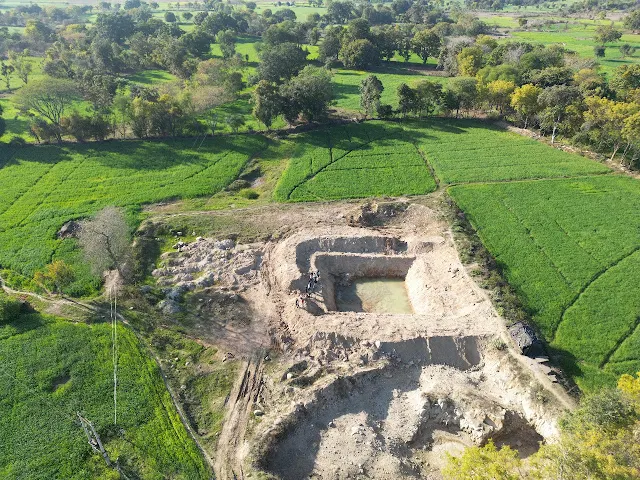Mobilizing an adequate response to climate change is often seen as an expensive task and then there is a lot of talk about who’ll bear the burden. However in rural areas both climate mitigation and adaptation can be integrated well with the promotion of sustainable rural livelihoods and in such conditions people become very supportive towards it. In such conditions climate response can progress much more smoothly without becoming burdensome.
This can be seen in the work of SRIJAN voluntary organization in many parts of India. This work emphasizes working with small and marginal farmers from weaker sections and among them even more with women. They are encouraged and helped by SRIJAN to maintain good farm production without getting dependent on chemical fertilizers and pesticides that are costly in economic as well as ecological terms. In fact the most effort by this organization is to promote natural farming. In several villages the production of eco-friendly manures and pest-repellants using local resources is encouraged and facilitated. In addition SRIJAN helps a lot with cleaning and de-silting water tanks and the collected silt when deposited in farms also contributes to improving natural fertility of farms.
This reduces the huge burden of fossil fuels to a significant extent as fossil fuels are used in the manufacture of chemical fertilizers and pesticides and their transport across long distances.
The high risks of chemical fertilizers for climate change have been summed up by the Union of Concerned Scientists in the following words (see their note titled ‘What is the problem with fossil-fuel based fertilizer’—“Manufacturing fertilizer requires increased energy output, primarily from power plants that burn fossil fuels and emit carbon dioxide (CO2); scientists have even estimated that producing the ammonia needed for fertilizer generates more CO2 than any other industrial chemical reaction. Fertilizer production also releases other heat-trapping gases including nitrous oxide (N2O) and methane (CH4), which are 265 and 28 times more potent than carbon dioxide, respectively.
“But unlike other manufactured products, fertilizers produce far more emissions in their use than in their production. An estimated two-thirds of the industry’s emissions are generated after farmers apply fertilizer in the fields, as naturally occurring soil microbes convert excess fertilizer into various compounds including N2O.”
As should be clear from this, any successful efforts to reduce chemical fertilizers (by replacing with organic manure) should have very beneficial climate impacts. However much some fertilizer industry linked research papers may try to confuse this issue, the beneficial impacts of replacing chemical fertilizers with organic manure are too obvious. At the same time the important role of mixed cropping and proper rotations should be emphasized.
In fact the adverse impact of chemical fertilizers on climate change is worsening further as natural gas for nitrogen fertilizer relies more on fracking as this may involve much more leaks of methane, which is around 25times more potent than carbon dioxide as a greenhouse gas.
The pursuit of ecologically destructive farming and related policies led to big loss of organic matter in soil and land, which in turn is responsible for a significant share of excess carbon dioxide in the earth’s atmosphere. On the other hand by again adopting ecologically protective methods in farming and related activities we can try to bring back the organic matter in soil to earlier levels over a period of a few decades, thereby helping much with tackling climate change.
The reduced dependence on chemical fertilizers, pesticides and weedicides reduces costs and debts of farmers, and on the other hand this improves the organic content of soil and its capacity to absorb carbon.
Hence by consistently promoting natural farming in recent times with a great deal of commitment, SRIJAN has been helping with climate change mitigation as well. In addition more tree growth on farms is encouraged by providing a model of farming in which even within small farms, very small orchards have been promoted by SRIJAN which emphasize relatively more hardy local species of fruit trees such as guavas and use natural farming methods. In addition several communities have been encouraged to grow dense forests on village common land—dense forests of mixed indigenous species called ‘tapovan’. In Markhera village of Tikamgarh district, for example, the village community participated enthusiastically to grow a tapovan containing about 1800 trees of nearly 36 indigenous species of trees.
Another big emphasis of SRIJAN is on water conservation. This helps to resolve the water crisis of villages and at the same time this improves the climate change adaptation of villages. There is progress in the direction drought-proofing of several villages and hamlets.
While choosing to work with farmers of poorer and economically weaker communities and more particularly with women farmers of these communities, SRIJAN chooses methods which help to reduce the costs and debts of farmers. Farmers are helped to improve the income and economic viability of their small farms in sustainable and ecologically friendly ways. All this including water conservation efforts helps to improve climate adaptation.
---
The writer is Honorary Convener, Campaign to Save Earth Now. His recent books include Saving Earth for Children, Planet in Peril, A Day in 2071, and India’s Quest for Sustainable Farming and Healthy Food


Comments